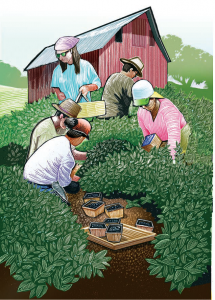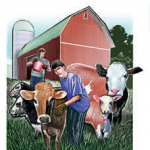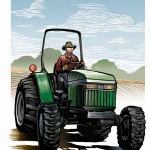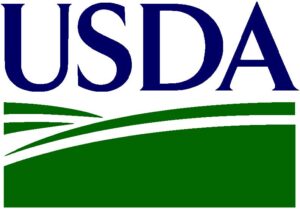 What do you remember about your first job? My memories are vivid and immediate. They have a lot to do with who I am today. Heading out to the pasture with my beloved pup summer mornings; learning to drive the old Oliver; wheelbarrow after wheelbarrow of manure up the plank and into the spreader – and the great gutter cleaner installation; finding a freshened heifer and her calf tucked away in a pasture corner; hot haying days and – if we were lucky – a quick run to the lake after; the first time I was left to do milking on my own. I remember the feeling of confidence and pride in what I was able to do, my connection to the animals and the land, the strength of my body, and how often my boss’s friends were impressed with what I was doing at 12 ,13, 14, etc.…years old.
What do you remember about your first job? My memories are vivid and immediate. They have a lot to do with who I am today. Heading out to the pasture with my beloved pup summer mornings; learning to drive the old Oliver; wheelbarrow after wheelbarrow of manure up the plank and into the spreader – and the great gutter cleaner installation; finding a freshened heifer and her calf tucked away in a pasture corner; hot haying days and – if we were lucky – a quick run to the lake after; the first time I was left to do milking on my own. I remember the feeling of confidence and pride in what I was able to do, my connection to the animals and the land, the strength of my body, and how often my boss’s friends were impressed with what I was doing at 12 ,13, 14, etc.…years old.
I worked on that small Vermont dairy from the late 70’s into
the mid 80’s. It laid strong foundational bones for my body, my love of physical work and accomplishment, and my confidence in taking on new tasks, skills, and responsibilities.
It also speaks to my current job, coordinating the UVM Extension 4-H Youth Farm Safety Project.
During those years of my adolescence, a little girl riding the tractor fender was killed in our county. My boss didn’t fix the seat on the tractor before heading out to harrow
– a decision that led to a three-week hospital stay and pain that continued through the years. I had a friend who played pool with one arm and one foot because he’d lost an arm in a PTO at ten.
Yes, it was a different time. Most tractors didn’t have roll bars and seat belts then. Those safety standards were developed and adopted by tractor manufacturers in 1986. It was in the mid-90’s that the U.S Congress approved – and funded – the National Action Plan for Childhood Agricultural Injury Prevention. Good news followed – over the next 10 years or so, the rate of childhood injuries on U.S farms and ranches went down 60%. Significant progress.
The work, however, is not done. Agriculture still has the second highest fatality rate of youth workers. While overall farm injury rates for youth have gone down, ATV and horse-related injury rates have actually gone up. The leading sources of fatal farm injuries to youth? Machinery, motor vehicles, and drowning. That’s for youth who work on, live on, and visit our farms.
The National Children’s Center for Rural and Agricultural Health and Safety is a terrific resource for keeping young people safe on farms. Check out their free “Safety Guidelines for Hired Adolescent Farm Workers.” It’s a helpful and straightforward guide on training, supporting, and supervising young workers in agriculture – and has both English and Spanish text.
The Youth Farm Safety Project is another resource to keep kids safe on our farms. In addition to our educational workshops, keep an eye out for our 2012 Safety Camps and the release of our new on-line diversified farm safety training site for 12-15 year olds. More on that later!
Until then, if you would like more information on the Youth Farm Safety Project feel free to contact me at (802) 656-2034 or kristen.mullins@uvm.edu.
Happy National Farm Safety and Health Week!








